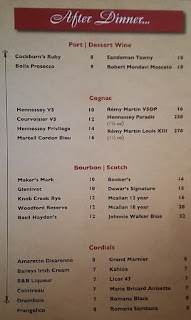Sorry for the delay on this post folks, working two jobs with one in the retail industry during the Holidays is making for a very stressful experience. I find that I am pulling 10-day straight runs between days off. During Thanksgiving, I worked 13 out of 14 days with Thanksgiving being my only day off. Then after a day off, I'm following that with a 17 out of 18 day clip. Luckily for me I'm motivated to get out of the hole of debt that I find myself in. But that is a conversation for another day. On to the Jack Rose Cocktail.
I kept with the spirit of Laird's Applejack that I profiled in my last post to make this classic cocktail. The cocktail is mentioned at least twice in Ernest Hemingway's The Sun Also Rises. Papa Hemingway published that book in 1926. In said passages, protagonist Jack Barnes visits the Hotel Crillon in Paris and has George the Barman make him the Jack Rose Cocktail. Here are two passages that mention the Jack Rose from Chapter VI and Chapter VIII respectively.
Hotel Crillon in Paris is located at 10, Place de la Concorde, 75008 Paris, France and according to the Hotel de Crillon website, the building was built in 1758, having been commission by King Louis XV with the greatest architect of his day, Jacques-Ange Gabriel designing the edifice. It would become the Hotel Crillon in 1909 after the previous owners the family of the The Counts of Crillon. The hotel would close in 2013 for massive renovations, having reopened early this year.
In terms of the cocktail, according to author Philip Greene of To Have and Have Another in his blogpost The Jack Rose, the Jack Rose Cocktail made its way in cocktail recipe guides during the early 1920's. Its unsure if the cocktail is named after notorious New York gangster "Bald Jack" Rose or the flower General Jacqueminot Rose named after Jean-Francois Jacqueminot who was a general under Napoleon. Greene also notes that there are two versions to this cocktail. To read up on both the origins of the cocktail and its potential naming, I recommend you read the amazing post by Greene: The Jack Rose. On to the cocktail.
I decided to use the classic ingredient list for the Jack Rose which is the Laird's, citrus and grenadine.
Today's cocktail showcase keeps with last week's profile of the Laird's Applejack. I decided to make the classic Jack Rose cocktail that is featured in Ernest Hemingway's The Sun Also Rises.
Now there are a variety of different recipes for this cocktail. Some call for more Applejack and Grenadine with less lime and or lemon juices. Some call for only lime or lemon. Since I like tarter cocktails, I went the tart route. Here is the recipe I used for the Jack Rose.
🌷 Jack Rose 🌷
🔸1.5oz Laird's Applejack
🔸0.5oz of both freshly squeezed Lime and Lemon Juice
🔸0.5oz Rose's Grenadine
Build ingredients in iced filled shaker. Shake and strain into a fresh glass. Express oils from lemon peel over cocktail and and garnish with the peel.I find the ratios I used led to what I was looking for: a nice and tart beverage. If you don't like it so tart then bump up the Grenadine from half an ounce to a full ounce and maybe just use lime or lemon juices at a smaller ratio. But for my tastes buds, the ratios I used were a-ok!!!
 |
| The Jack Rose |
For a later post I'll make the Harry MacElhone version of the Jack Rose which was listed in the 1922 cocktail guide Barflies and Cocktails.
Next on deck is Repeal Day and Krampusnacht, both of which fall on December 5th. Curious as to what I'll come up with at Finn's Corner? Follow me at my Instagram @SiscoVanilla, my YouTube Channel SiscoVanilla, my Twitter @SiscoVanilla and my Facebook page SiscoVanilla.
Until Then Happy Drinking,
SiscoVanilla
#SiscoVanilla
#SiscoVanillaAtTheMovies
#SiscoVanillaAtTheBookstore
#SiscoVanillaisStepping










